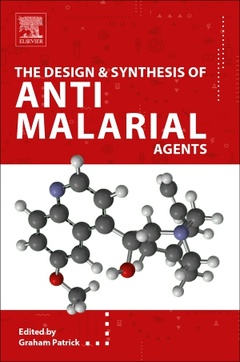Antimalarial Agents Design and Mechanism of Action
Coordonnateur : Patrick Graham L.

Antimalarial Agents: Design and Mechanism of Action seeks to support medicinal chemists in their work toward antimalarial solutions, providing practical guidance on past and current developments and highlighting promising leads for the future.
Malaria is a deadly disease which threatens half of the world?s population. Advances over several decades have seen vast improvements in the eff ectiveness of both preventative measures and treatments, but the rapid adaptability of the disease means that the ongoing search for improved and novel antimalarial drugs is essential.
Beginning with a historical overview of malaria and antimalarial research, this book goes on to describe the biological aspects of malaria, highlighting the lifecycle of the parasite responsible for malaria, the problem of resistance, genetic mapping of the parasite?s genome, established drug targets, and potential drug targets for the future. This sets the scene for the following chapters which provide a detailed study of the medicinal chemistry of antimalarial agents, with a focus on the design of antimalarial drugs.
Drawing on the knowledge of its experienced authors, and coupling historic research with current fi ndings to provide a full picture of both past and current milestones, Antimalarial Agents: Design and Mechanism of Action is a comprehensive yet accessible guide for all those involved in the design, development, and administration of antimalarial drugs, including student academic researchers, medicinal chemists, malaria researchers, and pharmaceutical scientists.
1. History of malaria and its treatment 2. Knowing one's enemy: the Plasmodium parasite 3. The cinchona alkaloids and the aminoquinolines 4. Artemisinin and artemisinin-related agents 5. Agents acting on pyrimidine metabolism 6. Antimalarial agents acting on hemoglobin degradation 7. Plasmepsins as targets for antimalarial agents 8. Falcipains as drug targets in antimalarial therapy 9. Drug targets in the apicoplast 10. Drugs targeting mitochondrial functions 11. The Plasmodium falciparum proteasome as a drug target 12. Transferases and their inhibition 13. Kinases and kinase inhibitors 14. Miscellaneous agents of clinical interest 15. Inhibitors of purine and pyrimidine pathways 16. Miscellaneous targets
- Consolidates both past and current developments in the discovery and design of antimalarial drugs
- Presents content in a style that is both thorough and engaging, providing a supportive and guiding reference to students and researchers from interdisciplinary backgrounds
- Highlights drug targets currently considered to be the most promising for future therapies, and the classes of compounds that are currently being studied and perfected
Date de parution : 06-2020
Ouvrage de 622 p.
19x23.3 cm
Thème d’Antimalarial Agents :
Mots-clés :
aldehydes; amino acids; aminopeptidases; aminopyrazole; aminoquinolines; antimalarial; antimalarial agents; apicoplast; arylthiophenes; asparagine ethylenediamines; aspartyl protease; atovaquone; ATP binding; ATP4ase; bestatin; calpain inhibitors; caseinolytic protease complex; cipargamin; cyclic peptides; cystatins; cysteine protease; cytochrome bc1 complex; dapsone; de novo pyrimidine biosynthesis; dihydrofolate reductase; dihydroisoquinolones; dihydroorotate dehydrogenase (DHODH); dihydropteroate synthase; dipeptidyl aminopeptidase; drug resistance; drug targets; epoxyketones; ethylenediamines; exopeptidase; falcilysin; falcipains; farnesyl pyrophosphate/geranylgeranyl pyrophosphate synthase; farnesyltransferases; fosmidomycin; FR900098; fumagillin; fumarranol; gallinamide; glucose-6-phosphate dehydrogenase; glutamate dehydrogenase; glyceraldehyde-3-phosphate dehydrogenase; hemoglobin; histo-aspartic protease; imidazolopiperazines; kinase inhibitors; kinases; licochalcone; life cycle; limonene; malarone<; ce:sup>; TM<; /ce:sup>; mallatojaponins; mechanism of action; medicagenin; medicinal chemistry; merozoites; mitochondria; mitochondrial electron transport chain; munchiwaren; mutations; non-mevalonate pathway; oocysts; peptide boronates; pharmacokinetics; phosphorylation; plasmepsins; Plasmodium falciparum; Plasmodium knowlesi; Plasmodium malariae; Plasmodium ovale; Plasmodium vivax; prenylation; proguanil; proteasome; protein kinases; pyrimethamine; quinine; quinoline methanols; scabellones; schizonts; serine hydroxymethyltransferase; spiroindolones; sporozoites; structure–activity relationships; sulfadoxine; sulfonyl fluorides; symplostatin; tectol; tetrahydrofolate; tetrahydroquinolines; thiapilidiaquinones; trophozoites; type II NADH dehydrogenase (NDH2); ubiquitin; vinyl sulfones; ß lactones


